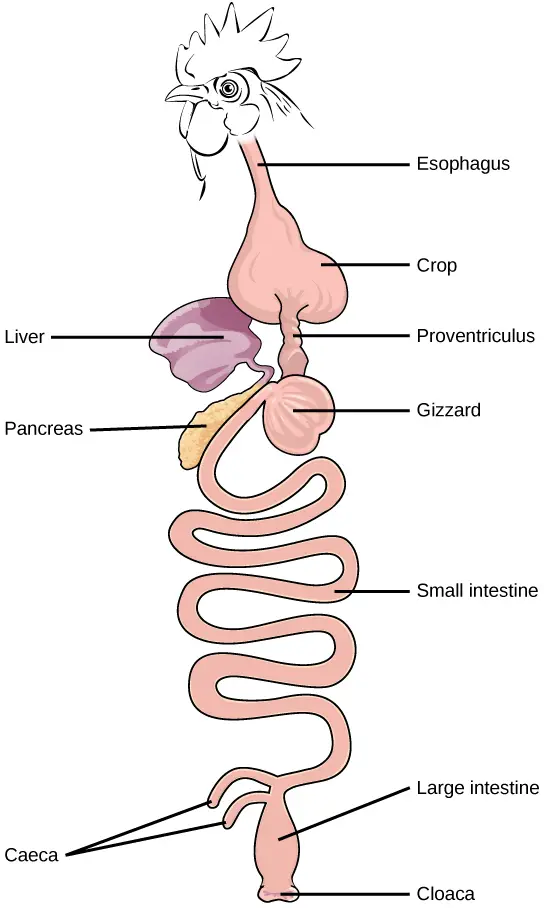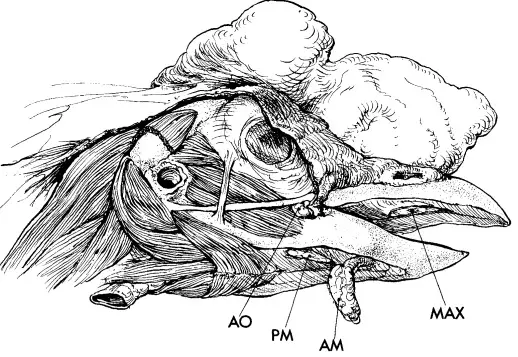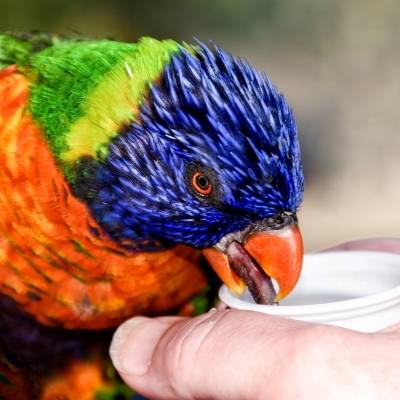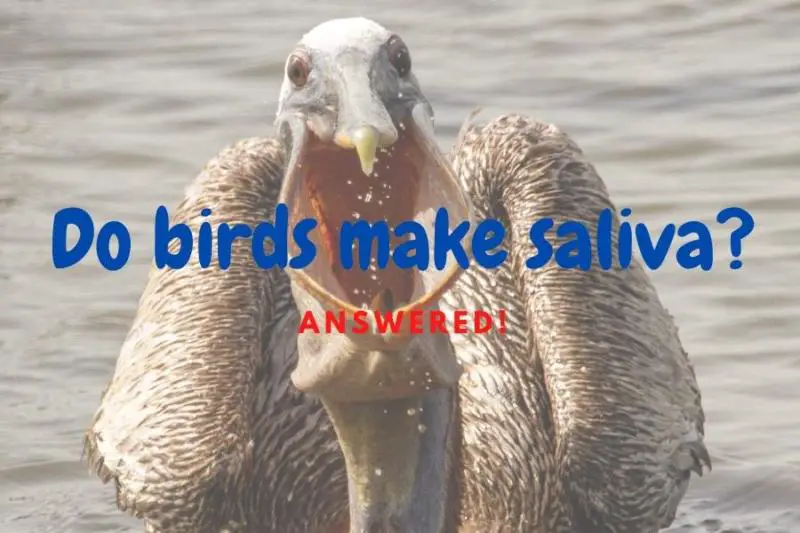Have you ever wondered if chickens can spit or droll? Or maybe you wonder if your pet parrots use saliva to digests their food? Well, then you are in the right place as I will answer these questions in this post!
Many bird species, including parrots, chickens, and ducks, produce saliva from fully functional salivary glands to aid in food swallowing. Some Swiftlets even make their nests from their own saliva! In contrast, some birds such as pelicans do not produce saliva at all.
However, because birds do not chew their food with their mouth like other animals do, they do not have the same requirement for saliva production.
Their bill may function to process the food gently before they swallow the food, but it does not allow any significant digestion of the food.
Throughout the animal kingdom, there are many variations in how different species produce saliva!
For example, fish do not produce saliva at all because they are submerged in water at all times. Whales on the other hand, are mammals that used to produce saliva, but lost their ability to make saliva not long after they entered the sea.
Reptiles, like Iguanas and turtles, are other interesting examples of animals that do produce saliva, but not to the extent of humans. An sea turtles almost don’t use their saliva at all.
Because birds and reptiles evolved from the same ancestor, it makes sense that most descendants within these groups produce saliva, but that some have lost the ability if saliva did not contribute significantly to their survival anymore.
Birds have a different digestive system compared to us and other mammals.
We use our saliva to lubricate and break down the food already while chewing it, however the birds swallow their food more immediately and let other parts of their digestive system do the work.
How do birds chew their food?
Birds need to process their food further inside their body rather than by their mouth, so they use specific organs that grind up the food instead of teeth for that.
The main organ to do so is called the gizzard. You may have seen or even tasted this organ when eating a whole turkey or chicken.
The gizzard works a bit like a grinder or mortar and pestle, which uses bits of stone or sand to rip the food into pieces.
This is especially important for birds that eat mostly seeds and is the reason why you need to provide chickens with shells or gravel – otherwise they would be like people without teeth!

The reasons why birds chew their food using an internal organ instead of their mouth are manifold.
One advantage may be that they do not have to spend precious time pausing to chew in between picking up seeds or hunting for insects.
Instead of chewing, they can spend all their time looking for seeds and catching insects.
The organ that allows for this delayed digestion is called a crop and it constitutes another crucial difference between our digestive system and that of our avian friends.
The crop is a kind of pouch on the esophagus (food pipe) that allows the bird to store food right after ingestion.
On a chicken, the crop is located right behind the chest and is the first stop for ingested food before it reaches the stomach.
The crop is most developed in birds that eat hard foods such as seeds, and some birds, including owls and geese, do not have one at all.
Figure from CNX OpenStax, CC BY 4.0 , via Wikimedia Commons.
Where are the salivary glands of birds located?
Birds like chickens and turkeys have multiple salivary glands distributed throughout their mouths. As seen in the figure below, they have two glands in the lower beak (PM and AM glands), one in the upper beak (MAX) and two on each side in the very back (AO).

Smaller birds of the passerine (songbird) family, like sparrows and blackbirds, mainly have the lower mandibular salivary glands and the Anguli Oris gland in the sides.
Do some birds produce more saliva than others?
For most birds, the saliva production will be sparse and you will not notice it in most birds used as pets. Parrots, for example, do produce saliva but keep a dry beak and tongue.
This is because most birds have their salivary gland located in the back of their mouth.
This placement is in contrast to animals that mix their food with saliva while chewing.
However, because birds do not chew their food in their beak, they only need the saliva for lubrication and digestion upon swallowing so the salivary glands are often placed in the back of their mouth.
Some birds that eat foods that are easy to swallow without further lubrication by saliva therefore do not need saliva and do not have detectable salivary glands.
One such bird is the pelican, which eats mostly fish that easily glide down on their own!
Interestingly, birds such as ducks and geese, that eat mostly plant material in water, have fully functional salivary glands, indicating that they do need the salivary enzymes or lubrication for the digestion of some of their dietary components (e.g. the bread you feed them!).
Woodpeckers also put their saliva to good use and produce thick and sticky as well as less viscous saliva.
They apply a bit of sticky drool to their tongue when fishing out insects from the holes they peck in tress, after which they use the thinner saliva to lubricate its throat for swallowing.
Some birds build their nests from saliva!
In contrast, saliva plays a crucial role in the life style of other bird species. On such bird is the White-nest Swiftlet that build its nest entirely from its own saliva!
Whereas most birds make their nest from small sticks, straw and feathers, these swifts produce thick rubbery saliva that they carefully mould into a nest – like a living 3D printer!
Because the saliva of the Swiftlets is made up mostly of a jelly-like protein, the nests of these birds are dissolved in a seasoned broth to make so called “bird’s-nest soup” – a popular, although not so ethically defendable, dish served as luxury food in some parts of Southeast Asia.
Conclusion
In summary, we have learned that birds do produce saliva, but not for spitting or drooling as humans do!
So if you see your parrot or pet chicken spit or droll, this is not normal and is likely to be symptoms of underlying disease.
FAQs on bird saliva!
I will answer a couple of the most commonly asked questions I get about birds and their saliva below!
Do sparrows have saliva?
Sparrows such as the house sparrow and other songbirds (passerines) do indeed produce saliva! However, contrary to other larger birds, they only have one salivary gland. Their salivary gland is placed in the front of the lower jaw just at the root of the lower beak.
Do turkeys have salivary glands?
Yes! Just as in chickens, turkeys have multiple salivary glands positioned in the very back of their mouths (like most birds) but also in the top, and somewhat in the front, of their mouth! These glands produce salivary to help the turkey swallow its food rather than aiding much in digesting via enzymes.
Do hummingbirds have saliva?
Hummingbirds have tiny salivary glands corresponding to their size, that they use to lubricate their tongue and throat. The swift movement and agility of the hummingbirds tongue as well as the proper flow of nectar into the throat of hummingbirds are dependent on a certain degree of lubrication from their saliva.
Do parakeets have saliva?
Yes, parakeets are parrots and all parrots produce saliva. Some more than others, e.g. lorikeets tend to produce a lot because they need it to digest the seeds and fruits that they eat.
Do cockatiels have saliva?
Yes – all parrots produce saliva! They have their salivary gland located in the back of their mouth and will not spit or drool. Their tongues will also not be wet from saliva, but they will use the saliva to swallow foods
Do conures have saliva?
Conures are parrots and all parrots produce saliva. Conures eat a variety of fruits, seeds, berries and nuts for which they need proper lubrication to swallow.
Are birds mouths wet?
Most often not! The mouth of most birds will feel dry because they do not produce saliva in the front parts like we humans and other mammals do. Birds produce most of their saliva in the very back of their mouths because they only use it for swallowing, and will therefore be relatively dry in most of their mouths/beaks.
Can birds lick?
Yes! In fact many parrots use their tongue not only for tasting but also to stabilize their grip when handling objects or climbing using their beak.

Do crows have salivary glands?
Yes, crows and other corvids like magpies and ravens have salivary glands and do produce saliva.
Do geese have salivary glands?
Yes! Geese and ducks produce a fair amount of saliva considering that they most often eat wet plants in the water or juicy grass leaves. They likely depend on the enzymes in their saliva for proper lubrication in their throat and digestive enzymes.
Do all birds have salivary glands?
No! Whereas most birds do have salivary glands, those birds that live in or get their food from the water such as pelicans or flamingoes do not have clearly developed salivary glands.
Furthermore, it is important to remember that there are huge variations in the amount of saliva that birds produce. And whereas most birds may have salivary glands, some show almost no production or need for saliva!
Before you leave!
Check out the rest of my posts on backyard birds here!
Maybe you would like to know if the Blue Jay or Cardinal dominates in the bird feeder hierarchy or how birds such as seagulls sleep at night? Or why mourning doves poop so much.




